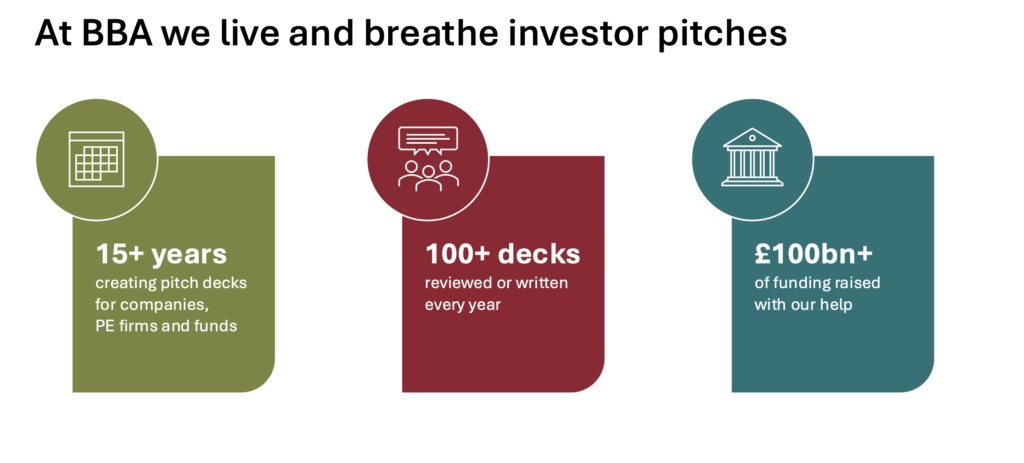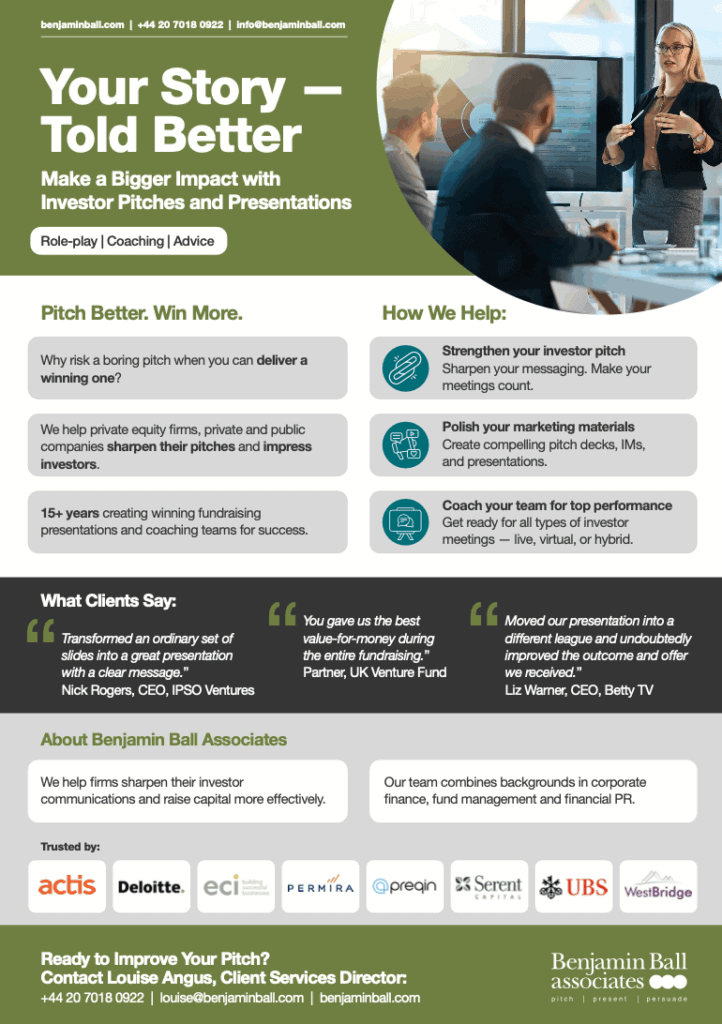
Investor Pitch Deck: Slides, Structure, Template and Examples
February 26, 2024
Updated 27 October 2025
Are you sending out your investor pitch deck? Are you writing a pitch deck for an investor meeting? Do you want an investor pitch deck that will get read? Do you need a pitch deck template for investors?
Whether you’re raising a VC round, a Series A or a new private equity fund, the core principles you need to follow are the same: clarity, brevity and a sharp story.

Meet the Author: Benjamin Ball
Ben is the founder of Benjamin Ball Associates and leads the presentation coaching and pitch deck creation teams. Formerly a corporate financier in the City of London, for 20+ years he’s helped businesses win with better pitches and presentations, particularly investor pitches. He is a regular speaker and a guest lecturer at Columbia Business School and UCL London. Follow Ben on LinkedIn or visit the contact page.
At Benjamin Ball Associates, we’ve been editing and writing investor pitch decks for over 15 years: for scale-up businesses, for PE funds and for other fundraising. Here our experts share their experience to help you pitch more effectively.
Speak to an expert. Get a free consultation
How to Write an Investor Pitch Deck That Investors Read
1. The Cover and a Great Executive Summary
Don’t neglect the power of a great cover. A bad cover has a boring message like “Investor Presentation”. Instead, start to sell your proposition from the start. For example, “Benjamin Ball Associates – the best way to improve your success with investors.”
Next, use page 2 to give a powerful overview of your proposition. In this way, anyone glancing at your pitch deck gets to understand the value of your offer quickly and easily. This is probably the hardest page to write in the entire pitch, it needs to be short, powerful and persuasive. Most people write too much on their page 2.
For example, selling our services, I might start with a page like this to outline our offer:

2. The 10 Slides Investors Expect
Most people put too much into their investor pitch. So, instead, use 10–12 slides. Fewer words, more clarity. Here’s the set of pages most investors expect to see in a first meeting:
1. Problem – What pain are you solving, and for whom?
Example: “Finance teams spend 12 hours a week fixing invoice errors.”
2. Solution – How you fix it. Keep this to one slide.
Example: “AI-assisted invoice reconciliation that halves processing time.”
3. Market – The size of your opportunity and who’s in it.
Tip: Show both total market and your reachable segment. This shows the upside is big enough.
4. Business model – How money flows in and out.
Example: “Subscription model, £500/month per site, 88% gross margin.”
5. Traction – What you’ve achieved so far.
Example: “£220k monthly recurring revenue, 340 paying customers, 6.2% weekly growth.”
6. Go-to-market – How you’ll grow your customer base.
Tip: Investors want to see you know your sales channels and unit economics.
7. Competition – How you compare with rivals and substitutes.
Example: A simple 2×2 chart with your differentiator labelled clearly.
8. Team – Why you’re the right people for this.
Tip: Show relevant track records, not job titles.
9. Financials – Your 3–5 year projections at a high level.
Example: “£1.2m revenue next year, reaching profitability in Year 3.”
10. Ask – How much you’re raising and what it funds.
Example: “£5m to expand into new markets over 18 months.”
Pro Tip
Keep your slides simple, visual and concise — one key message per page only.
Investors will skim before they read, so make every headline self-explanatory.
Need a second opinion on your pitch deck?
Send us your draft and we’ll review it for clarity, story and investor impact.
Speak to Louise for a free consultation →
3. What to Say on Each Slide (with Examples)
A great investor deck isn’t just about what slides you include — it’s about what you say on them. The best decks read like a story: problem, solution, proof, and promise. Here’s how to bring each slide to life.
1. Problem – open with a clear pain
Show that you understand your customer’s world. Keep it simple, specific, and human.
Good example:
Mid-sized manufacturers lose 10% of revenue each year due to poor stock tracking. Their teams spend hours fixing errors.
Avoid:
“Our software improves operational efficiency across multiple verticals.” (It sounds vague and corporate.)
2. Solution – make it obvious
Explain how your product or fund solves the pain. One sentence, one visual, one big idea.
Good example:
Our mobile-first inventory platform cuts stock errors by 80% within three months.
If you’re a fund, summarise your investment focus:
We invest in European climate-tech scaleups that deliver both returns and measurable impact.
3. Market – show size and focus
Investors want to see upside and realism. Combine a large opportunity with a clear niche.
Good example:
“Global logistics software is a £25bn market, growing 14% annually. Our initial target segment — mid-sized warehouses — represents £1.2bn.”
Tip: Add one chart and one key number. That’s it.
4. Business Model – show how money flows
Make your revenue model obvious and defensible.
Example:
We sell annual SaaS subscriptions: £500 per site per month, with 88% gross margin. Renewal rate 92%.
If you’re raising a fund:
“2% management fee, 20% carry, target net IRR 18%.”
5. Traction – prove it’s working
This is where belief turns into confidence. Use metrics, logos, and milestones.
Example:
£220k MRR (+6.2% week-on-week).
340 paying clients across Germany, Sweden & UK.
95% customer retention.
Visuals help: timeline charts or client logos make this page pop.
6. Go-To-Market – how you’ll scale
Explain your plan to grow customers efficiently.
Example:
Outbound pilots converted at 15%. Next, we’ll invest in partner-led channels to double reach.
£250k of this round funds one senior SDR and targeted LinkedIn ads.
Keep it short and concrete.
7. Competition – prove you understand your space
Show that you know your competitors and why you win.
Example:
Competitors: X (enterprise), Y (SMB), Z (API-only).
We win on ease of integration and 48-hour setup.
Use a simple visual grid — and keep it factual, not boastful.
8. Team – why you’ll win
Investors back people before products. Highlight relevant track records and complementary skills.
Example:
Sarah Jones – ex-Amazon ops lead (scaled £50m product line)
Tom Reid – CTO, built and sold two B2B SaaS firms.
A clean photo layout works best — avoid long CVs.
9. Financials – the future at a glance
Don’t drown investors in numbers. Show direction, drivers, and realism.
Example:
2025 revenue £1.2m
2026 £3.8m
Break-even in Q4 2026
Cash positive by 2027.
Explain assumptions briefly beneath the chart.
10. Ask – finish strong
Spell out what you want and what it delivers.
Example:
We’re raising £1m for 18 months’ runway.
Funds go to product development (40%), sales (40%), and operations (20%).
Target close: Q2 2025.
Close with one confident sentence about your vision:
We’re building the go-to platform for next-generation logistics.
Pro Tip
Before you show a single slide, test your “one-line story” out loud.
If it doesn’t make your audience nod instantly, rewrite it. The rest of your deck should support that single idea.
4. Common Pitch Deck Mistakes
Even the most promising businesses lose investors’ interest because of simple, avoidable errors. Before you share your deck, check you’re not making any of these.
1. Too long – If your deck is more than 15 slides, most investors won’t finish it. Keep your main story short and save detail for the appendix.
Fix: Distil every slide down to one clear message. If you need to explain further, add a backup slide.
2. No clear “ask” – Many founders forget to state how much they’re raising or what it’s for.
Fix: Always end with a confident “ask” slide. Investors need clarity to act.
3. Walls of text – Slides filled with paragraphs make people tune out.
Fix: Fewer words, bigger fonts. Use visuals or numbers to tell your story. If a sentence doesn’t earn its place, delete it.
4. No story – Listing facts isn’t persuasive. Investors buy into a narrative that connects problem, solution, traction and opportunity.
Fix: Start with a one-line story and thread it through every slide. Example:
“We’re helping small builders win back their time with a tool that halves admin work.”
5. Unrealistic forecasts – If your chart looks like a rocket ship, investors will raise eyebrows.
Fix: Be optimistic but credible. Show assumptions behind your growth and mention the levers you’ll pull to get there.
6. Ignoring competition – Never say “we have no competitors.” It’s not true – ever.
Fix: Show you know the market. Position yourself confidently but humbly.
7. Team mismatch – Sometimes, the team slide feels like an afterthought.
Fix: Make your people a strength. Show why your mix of skills gives you an edge. With a great team you may lead with this page.
8. Plodding through the slides – When pitching live, avoid ‘taking people through the presentation’. Instead have a conversation.
Fix: Treat your slides as cues, not scripts. Rehearse your story until it sounds natural and conversational.
5. Case Study: How Bamboo Capital Improved Its Investor Pitch
When Bamboo Capital Partners, an impact investment firm with over $250 million AUM, welcomed two new managing partners, they wanted their messaging to reflect the refreshed leadership and vision.
The challenge:
Their existing investor materials no longer captured who they were or what made them different among impact investors.
Our approach:
We worked with the senior team to:
- Redefine their core investor narrative — from the one-line proposition to the fund’s “red thread”
- Rebuild their pitch deck around that new story
- Align the website, marketing materials, and annual Impact Report with the same messaging
The result:
A sharper, more compelling investor story that resonated resulting in new and different investors.
“From the initial messaging session through to full implementation, Benjamin Ball Associates helped us define and explain our unique value proposition. As a result, we’ve attracted new and different investors.”
— Florian Kemmerich, Managing Partner, Bamboo Capital Partners
Takeaway: Clear messaging and a consistent story across every investor touchpoint doesn’t just look professional — it opens new doors.
Final Tip: If your story is simple, your numbers make sense, and your slides feel clean, you’re already ahead of 90 per cent of the competition.
6. Download Template Investor Pitch Deck
See this investor pitch deck example to illustrate all the points above:

Give Yourself the Best Chance with a Winning Pitch Deck
A strong investor pitch deck doesn’t just share numbers, it tells a story that investors want to be part of. When your slides are simple, your story is clear and your delivery feels natural, you stand out from the crowd.
That’s where we come in. At Benjamin Ball Associates, we help founders, CEOs and fund managers turn good investor decks into great ones. You’ll work with coaches who’ve sat on both sides of the table, so you get practical feedback that makes a real difference in the room.
We’ll help you:
- Sharpen your investor message so it’s clear and memorable
- Refine your slides to show what really matters
- Build confidence for investor meetings and Q&A sessions
💬 “I honestly thought it was the most valuable three hours I’ve spent with anyone in a long time.”
— Mick May, CEO, Blue Sky
Let’s Strengthen Your Next Investor Pitch
Talk to us about your current deck, and we’ll recommend the quickest way to make it investor-ready.
📞 Speak to Louise on +44 20 7018 0922
Speak to an expert. Get a free consultation
Why Choose Us:
Transform your pitches and presentations with tailored coaching

We can help you present brilliantly. Thousands of people have benefitted from our tailored in-house coaching and advice – and we can help you too.
“I honestly thought it was the most valuable 3 hours I’ve spent with anyone in a long time.”
Mick May, CEO, Blue Sky
For 15+ years we’ve been the trusted choice for leading businesses and executives throughout the UK, Europe and the Middle East. We’ll help you improve corporate presentations through presentation coaching, public speaking training and expert advice on pitching to investors.
Some recent clients

Unlock your full potential and take your presentations to the next level.
Speak to Louise on +44 20 7018 0922 or email info@benjaminball.com to transform your speeches, pitches and presentations.
Speak to an expert. Get a free consultation
7. FAQs: Your Investor Deck Questions Answered
How long should an investor pitch be?
Plan for around 20 minutes plus discussion.
Open with a 60-second summary, then a three-minute overview before you expand into detail.
How many slides is ideal?
Keep it to 10–12 slides for your main deck.
Add an appendix for detail that only appears if asked.
What’s the best way to show traction?
Use numbers, proof and stories.
Include growth rates, KPIs, customer logos or short case studies. Up-and-to-the-right graphs are very effective.
Do I need financial projections?
Possibly, but keep them simple. Show direction and logic, not perfection.
Explain your assumptions and how you’ll track progress.
How do I handle tough investor questions?
Listen fully, pause, then answer directly.
If you don’t know, say so and outline how you’ll find out. Investors respect honesty more than waffle.
What makes a pitch deck stand out visually?
Clarity. Use consistent fonts, light backgrounds, and no more than one idea per slide.
Good design supports your message, it doesn’t compete with it. That’s why we have an in-house designer for our winning investor pitch decks.
Should I send the deck before or after the meeting?
Most investors prefer a short version in advance (10–12 slides).
Bring a slightly longer version with appendix slides for the meeting itself.
Improve Your Next Investor Pitch
Talk to us about your current deck, and we’ll recommend the quickest way to make it investor-ready.
📞 Speak to Louise on +44 20 7018 0922
Speak to an expert. Get a free consultation

Download our free
fact-sheet today HERE
Contact us now for free consultation
Start improving your pitches and presentations now
Contact us now and speak to an expert about getting award-winning coaching, training and advice